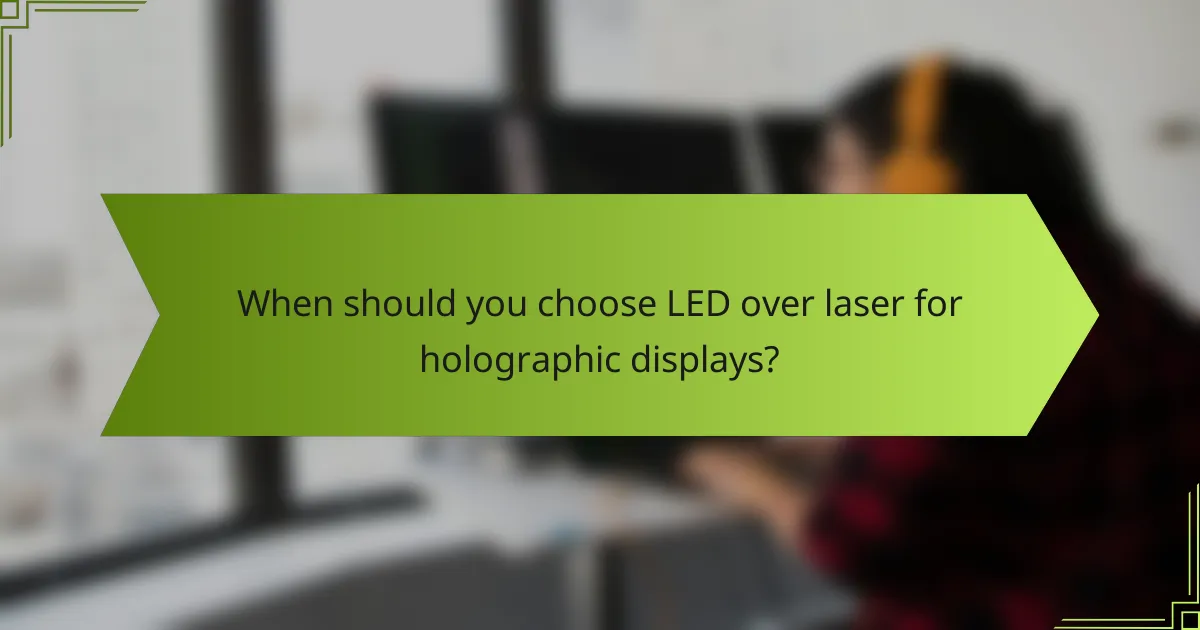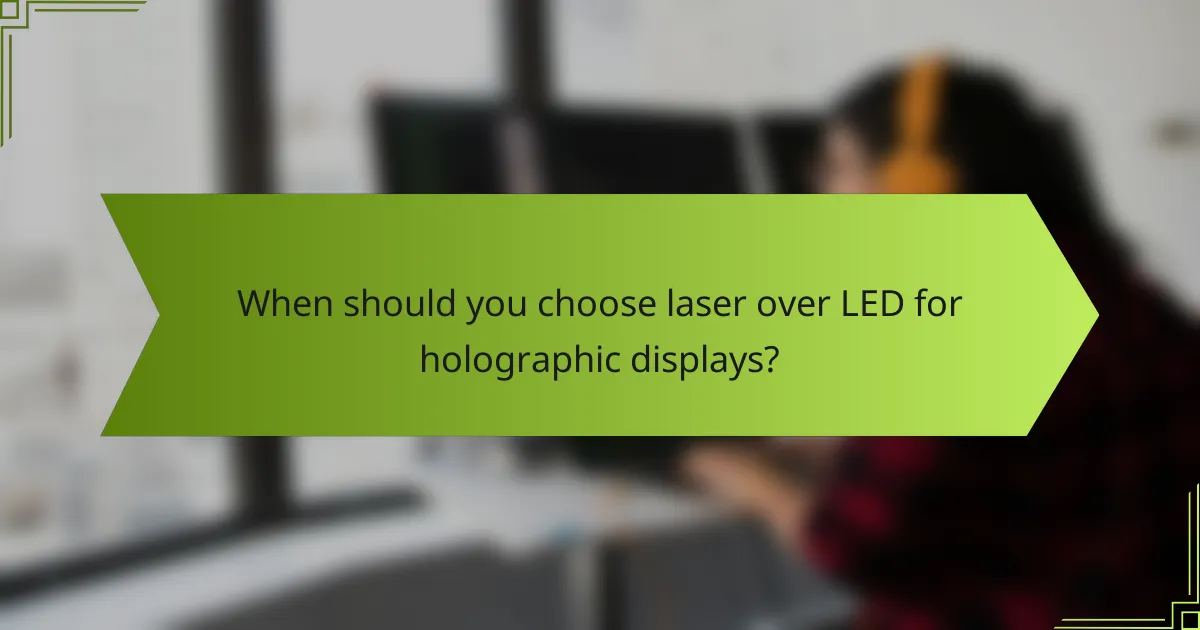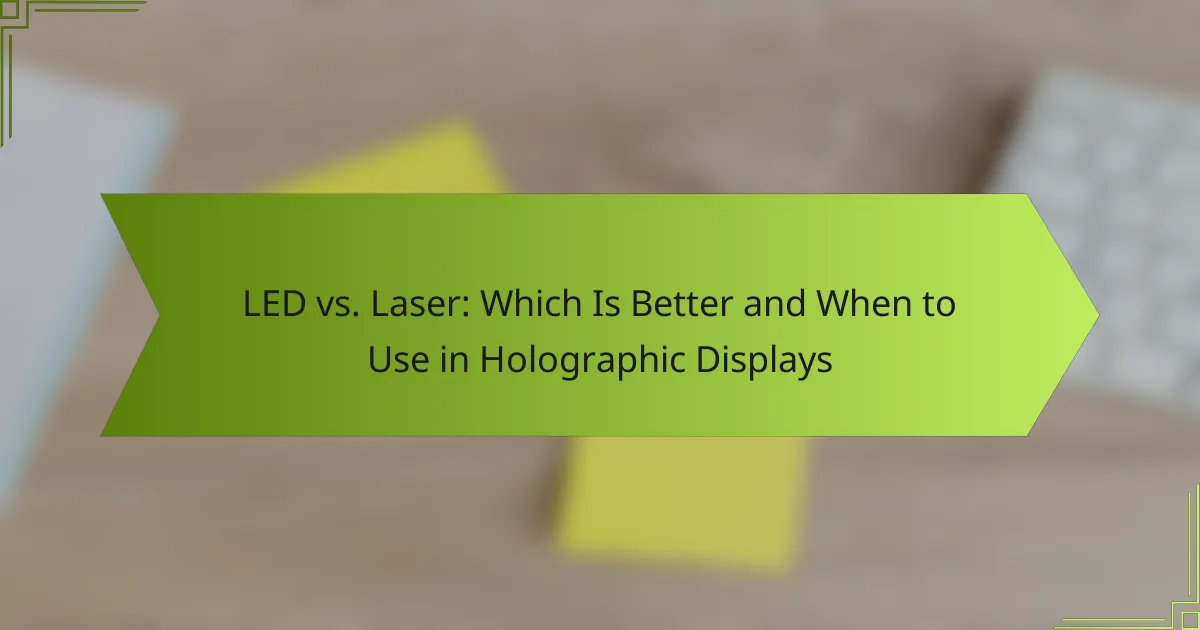When it comes to holographic displays, the choice between LED and laser technology can significantly impact visual quality and application suitability. LEDs are favored for their energy efficiency, longevity, and vibrant colors, making them ideal for cost-effective and versatile setups. In contrast, lasers excel in producing intense light and precise wavelengths, offering superior visuals for high-end applications. Understanding these differences is crucial for selecting the right technology based on specific needs and environments.

What are the advantages of LED in holographic displays?
LED technology offers several advantages for holographic displays, including energy efficiency, longevity, and vibrant color reproduction. These benefits make LEDs a popular choice for creating high-quality visual experiences in various applications.
Energy efficiency
LEDs are known for their energy efficiency, consuming significantly less power compared to traditional light sources. This efficiency translates to lower electricity costs, making them an attractive option for large-scale installations or long-term use.
For example, an LED display can use up to 80% less energy than an equivalent incandescent display, which is particularly beneficial in commercial settings where operational costs are a concern.
Long lifespan
LEDs have a remarkably long lifespan, often exceeding 25,000 hours of use. This durability reduces the frequency of replacements, minimizing maintenance efforts and costs over time.
In contrast, traditional lighting solutions may need replacement every few thousand hours, making LEDs a more reliable choice for continuous operation in holographic displays.
Vibrant color reproduction
LED technology excels in producing vibrant colors, which is crucial for holographic displays that aim to create immersive experiences. The ability to emit a wide spectrum of colors enhances the visual quality and realism of the displayed images.
With advancements in LED technology, displays can achieve high color accuracy and brightness, making them suitable for applications ranging from advertising to artistic installations.
Lower heat emission
LEDs generate significantly less heat compared to other lighting technologies, which can be advantageous in maintaining optimal operating conditions for holographic displays. Lower heat emission reduces the need for additional cooling systems, leading to further energy savings.
This characteristic also contributes to the longevity of the display components, as excessive heat can degrade electronic parts over time.
Cost-effectiveness
While the initial investment in LED technology may be higher than traditional options, the long-term savings in energy consumption and maintenance make them cost-effective. Businesses can benefit from reduced operational costs and fewer replacements over the lifespan of the display.
Additionally, the increasing availability of LED components has led to competitive pricing, making them more accessible for various applications, from retail to entertainment.

What are the advantages of laser in holographic displays?
Lasers offer several key advantages in holographic displays, making them a preferred choice for high-quality visuals. Their ability to produce intense light and precise wavelengths enhances the overall viewing experience.
Higher brightness levels
Lasers can achieve significantly higher brightness levels compared to LED sources, often exceeding 10,000 nits. This increased brightness is crucial for holographic displays, especially in well-lit environments where visibility can be a challenge.
The intense brightness from lasers allows for clearer images and vibrant colors, making them ideal for applications like advertising and immersive experiences where impact is essential.
Greater depth perception
Laser technology enhances depth perception in holographic displays by providing coherent light that improves spatial resolution. This coherence allows for better differentiation of layers in a holographic image, creating a more lifelike appearance.
Users often report a more immersive experience with holograms that utilize lasers, as the depth cues are more pronounced, making objects appear to float in space rather than being flat images.
Better image stability
Lasers contribute to better image stability in holographic displays by minimizing motion blur and flicker. The coherent nature of laser light ensures consistent image quality, even during rapid movements.
This stability is particularly beneficial in applications such as virtual reality and simulations, where maintaining a clear and stable image is crucial for user comfort and engagement.
Wider color gamut
Lasers can produce a wider color gamut than traditional LED displays, allowing for more vibrant and diverse color reproduction. This capability stems from the ability of lasers to emit light at specific wavelengths, covering more of the visible spectrum.
A wider color gamut enhances the realism of holographic images, making them more appealing and engaging for viewers, particularly in artistic and entertainment contexts.
Enhanced contrast ratios
Laser-based holographic displays typically offer enhanced contrast ratios, which improve the differentiation between light and dark areas in an image. This is due to the ability of lasers to produce deep blacks alongside bright highlights.
High contrast ratios are essential for creating striking visuals, making laser technology particularly suitable for applications where detail and clarity are paramount, such as medical imaging or high-end presentations.

When should you choose LED over laser for holographic displays?
Choose LED for holographic displays when cost, indoor settings, and lower ambient light conditions are priorities. LEDs are generally more affordable and versatile, making them suitable for various applications, especially where brightness and energy efficiency are essential.
Budget constraints
LED technology is typically more budget-friendly compared to lasers, making it an attractive option for projects with limited funding. The initial investment for LED displays often falls within a lower range, which can be crucial for businesses or events with tight financial resources.
Additionally, the operational costs of LEDs tend to be lower due to their energy efficiency and longer lifespan. This can lead to significant savings over time, especially in large installations or continuous use scenarios.
Indoor applications
LEDs excel in indoor environments where controlled lighting conditions enhance visibility. Their ability to produce vibrant colors and high brightness levels makes them ideal for exhibitions, retail displays, and presentations.
In contrast, lasers may be less effective in indoor settings due to their potential for glare and reflections. For applications such as trade shows or corporate events, LEDs provide a more consistent and visually appealing experience.
Lower ambient light environments
In settings with lower ambient light, LED displays can perform exceptionally well, maintaining clarity and color accuracy. This makes them suitable for environments like theaters, museums, or dimly lit retail spaces.
While lasers can offer high brightness, they may not be necessary in these conditions and could lead to unnecessary costs. Opting for LEDs in such scenarios ensures an optimal balance of performance and affordability.

When should you choose laser over LED for holographic displays?
Choosing laser over LED for holographic displays is ideal when high precision and brightness are essential. Lasers provide better coherence and intensity, making them suitable for specific applications where visibility and detail matter.
Outdoor applications
In outdoor settings, lasers outperform LEDs due to their ability to maintain brightness in direct sunlight. This is crucial for installations like advertising displays or public art, where visibility is paramount. Lasers can penetrate ambient light better, ensuring that holographic images remain clear and vibrant.
When considering outdoor use, ensure that the laser system is weather-resistant and complies with local safety regulations. For example, in the EU, laser safety standards must be adhered to, particularly in public spaces.
High-brightness requirements
For applications requiring high brightness, such as large-scale presentations or immersive environments, lasers are the preferred choice. They can achieve higher lumens per watt compared to LEDs, resulting in more vivid displays. This is particularly beneficial in environments with high ambient light or when projecting over long distances.
When selecting a laser system for high-brightness needs, consider factors like power output and beam quality. A well-calibrated laser can provide a significant advantage in clarity and color accuracy, making it suitable for professional-grade holographic displays.
